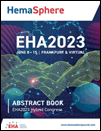PB2035: REGULATION OF THE EGR2/FASL SIGNALING PATHWAY IS POTENTIALLY MEDIATED BY E3 UBIQUITIN PROTEIN LIGASE 2 IN BONE MARROW CELLS
Abstract Topic: 11. Bone marrow failure syndromes incl. PNH - Biology & Translational Research
Background: It is undeniable that E3 ubiquitin protein ligase harbors multifaceted properties to regulate number of cellular processes. Among them, the oncogenic potential of WW domain-containing E3 ubiquitin protein ligase 2 (WWP2) has recently gained significant attention, however, its precise molecular function remains to be determined. We previously found the downregulation of WWP2 in aplastic anemia, a rare hematopoietic/bone marrow disorder.
Aims: Herein, as a follow-up, we sought to investigate the hypothesis that WWP2 may have molecular genetic changes or abnormal molecular regulation in bone marrow (BM) HSCs, thereby affecting its downstream signaling pathways, resulting in hematopoietic failure in AA patients.
Methods: BM cells derived from mince were transfected with WWP2 lentiviral over-expression and interference vectors. The apoptosis and proliferation of cells, and the expression of WWP2 and its downstream factors were detected.
Results: The analysis showed that the inhibition of WWP2 decreased proliferative capacity and increased apoptosis of BM cells, whereas WWP2 overexpression rescued this effect. Considering the preponderance of WW domain proteins in the EGR2-mediated FasL apoptosis pathway, we next observed that suppression of WPP2 leads to increased expression of key regulatory proteins of EGR2/FASL pathway (EGR2, FASL, FADD), and pro-apoptotic proteins (caspase 3, caspase 8, caspase 9, and Bax). Conversely, inhibition of EGR2 attenuated the apoptosis effect induced by WWP2 suppression in BM cells. In addition, we performed Insilco modeling to confirm potential WWP2- EGR2 protein interactions. Thus, our in vitro analysis provided evidence that downregulation of WWP2 increases the expression of FASL and FADD, thereby activating caspase 8 and inducing caspase 3-associated apoptosis in BM cells.
Summary/Conclusion: In future, in vivo validation may ensure WWP2 as a putative mediator of the EGR2/FASL pathway and as a potential therapeutic target in aplastic anemia.
Keywords: Aplastic anemia




